 Today’s post from Mark Kuhn addresses an interesting application that I hadn’t thought about before – a combination of electrified hardware and a key-operated lock on the same door. I’d love to hear opinions from readers on this…
Today’s post from Mark Kuhn addresses an interesting application that I hadn’t thought about before – a combination of electrified hardware and a key-operated lock on the same door. I’d love to hear opinions from readers on this…
~~~
Here’s a sample of a typical conversation I have with Lori…
Me: “Look at this crazy door application.”
Lori: “That would make a good iDigHardware post.”
 Recently the subject was doors to which more than one egress code apply.
Recently the subject was doors to which more than one egress code apply.
I was writing a hardware specification for a jewelry store, which is not normally a very complicated (or even interesting) project to specify. But this jewelry store must have had issues in the past and they were looking for a solution.
Below is a snippet of the plans showing the doors in question:
DOOR A: They want to control entry, allowing one patron at a time through the door, but must also allow free egress. This was done with electromagnetic locks released by a sensor, as covered in the 2021 IBC, Section 1010.2.12. Those of you who are familiar with this code know that we can lock an egress with a mag-lock if we meet ALL of the criteria stated in the code:
- Have a sensor which releases the mag-lock as someone approaches the door on the egress side (free egress at all times)
- Have a secondary “request-to-exit” button release the mag-lock (in case the sensor fails) for a minimum of 30 seconds, independent of the access control system
- Have the fire alarm release the mag-lock
- Have loss of power release the mag-lock
The term “loss of power” is what gave the owner heartburn, as they didn’t want the store unlocked during a power outage. So they asked if they could put an additional lock on the door to lock the store after hours. We know that according to IBC-2021, Section 1010.2.4, Item 3, we are permitted to lock this door with a key operated locking device (AKA double cylinder deadbolt) provided it meets the requirements in Item 3:
- The locking device is readily distinguishable as locked
- There is signage that reads “THIS DOOR IS TO REMAIN UNLOCKED WHEN THIS SPACE IS OCCUPIED”
The question is…can I apply both IBC-2021, Section 1010.2.12 and Section 1010.2.4 to the same door?
After reading both codes thoroughly, I couldn’t find anything that would prohibit this application…what do you think?
The Plot Thickens….
Let’s not forget DOOR B: They want to not only control entry through this door BUT they want to also control egress through this door (RED FLAG!!!). Lucky for the owner, according to IBC-2021, Section 1010.2.13, we can do this with a delayed egress lock (in a Group M-mercantile occupancy). In this case we used a delayed egress mag-lock.
So if you want to shop at this store, You will first be “buzzed-in” through Door A and then be “buzzed-in” through Door B. (Yes, I still use the term “buzzed-in”!) And when you’re all done shopping and ready to leave the store, an employee will use a remote release button to allow you to exit through Door B without the 15-second delay, and then you can freely exit through Door A. HOWEVER, if you try to leave without authorization, you will be delayed at Door B for 15 seconds while an alarm sounds, giving the armed guard who also works at this store time to intervene.
By the way, the other place we typically (and more frequently) see this type of controlled entry/exit is at marijuana dispensaries.
You need to login or register to bookmark/favorite this content.


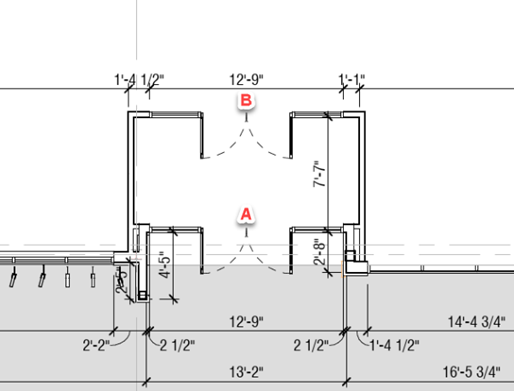
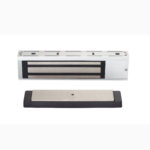


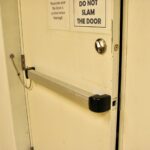
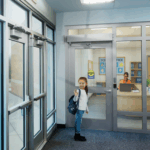

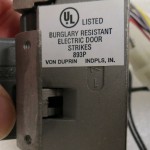
I wouldn’t want a motion sensor at Door A. Anyone who is in the vestibule will trigger the motion sensor, essentially unlocking the mag lock, allowing anyone to enter from outside. I’d use some kind of touch bar or exit bar with a switch to release the mag lock.
Justin, I agree that would also be a good approach and meet IBC 2021 1010.2.11 for door mounted hardware release.
We had this issue on a dormitory; activating sensor to release electro-mag thus releasing the entry security system.
2 solutions:
Both involve eliminating the electro-mag, release sensor and interior emergency release button.
1: install mullion with elec. Strike to buzz patron in. Rim panic devices secure the doors.
2: as previously mentioned; install exit devices with electric bar retraction/latch.
Exterior trim could be electronic access control with key override entry only or just simple key entry only.
Either way, the doors would be secure upon loss of power and egress code compliant.
Building entry should always be fail secure.
Thanks Dave!
– Lori
I would not have Gone with A Maglock for Door A, I would of gone with a Panic Device on Both Doors, with One Door having Electrified Latch Retraction, same for the Inside door, with Switches mounted to each set of doors, to stop the opposite door from opening with the access system to release the other door until the door was closed and Locked.
Easily accomplished with Door Contacts and Latch Bolt Monitor Switch in the Panic Device.
This allows the doors to provide Free Egress, no need for Fire Alarm Permit to add in the Maglock Power Supply, and you can keep the system working with Battery Back-up.
The Big Issues in Canada now, is you must have Stamped Engineered Drawings, Building Permit, before starting this work.
Once Completed, you have to use the same engineer that created and signed the Drawings to be on site to verify all new Items added to the Fire Alarm System and the Doors Work as Per Building and Fire Codes.
We are no longer allowed to Use REX Motions to Release Maglocks, as they do not meet the Building Code for Door Release Hardware, which cannot be mounted more than 48″ off the Ground, Be directly attached to the door with the Maglock also.
Jim,
I appreciate your perspective on this and also the chance to get a better understanding of how this is handled in Canada. This post has received a lot of discussion around different ways of handling these openings. I didn’t go into a much of the back story because of wanting to focus on the particular codes that were at play. BUT…I think it bears mentioning that these openings were both existing and the doors and frames were going to be reused. This was a major factor in the hardware selections.
However, I am really happy that everyone took time to go into specifics about how they would treat these openings, because it was a catalyst for me to write another post on specifying hardware…stay tuned for that post over the coming weeks 🙂
-Mark
Mark,
In Canada, any Repairs to the Doors that just require replacing existing with existing is allowed, but Changes to the Locking Hardware, requires the doors and hardware be brought up to code.
If the Doors are Equipped With Maglocks originally, we are required by law to bring the doors, and Maglock System up to Current Requirements,
There is actually laws in place that require any skilled person who finds a door(s) in a building that do not meet current requirements, to report the deficiencies with in 10 days of being at the building. If we do not we can be fined personally as well as the company we work for fined as well. The City here has not started to enforce this as yet, as there was not the political will in the past, to do so. But there was a few incidents here in the last 2 years where peoples lives were put at risk, now there is a 180 Deg Turn around on this way of doing business. It is now looked at, if it is not correct, they provide the building owner/management 30 days to issue a Purchase Order to get the issue(s) corrected.
Our Biggest issue going forward is getting all of the Suppliers and Contractors that provide this type of materials and work, up to speed on the current and changes coming in the next 4 to 5 years that will actually turn the industry on its head to fathom the massive changes coming down the pipeline,
How do you say Tough Love….